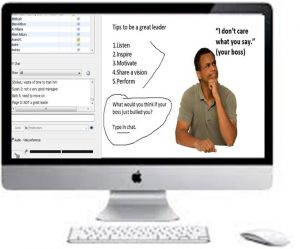Content vs Context
- eLearning module you actually worked through
- the last webinar you were subjected to
- the last compliance training you were part of
etc.
You probably:
- Switched off mentally.
- Started doing other things while supposedly listening.
- Didn’t want to be there.
- Left feeling it had been a waste of your time.
Right?
Why?
I’m certain that content wise, it was accurate and well presented. So what was the problem? Here we’ll look at the most likely cause and what we can do about it. More importantly, let’s look at what this means to you in your role as a trainer, training designer, webinar facilitator, eLearning designer etc
We often hear the phrase
Content is King
in training, but I’d suggest it has to be updated to
Context is King
Without context, no matter how good the content is, learners switch off because they cannot recognise where or why they would use the content in their daily work.
Definitions
| Training Content | principles and concepts to be taught such as legislation, the principles of how something works, a process etc. |
| Training Context | situations that throw light on meaning ie something that brings content into the world of the learner and helps determine the meaning. |
Often, we are so focused upon the content that we forget to position this for our learners. We forget to put them into the situation when they’ll use the content. If learners cannot see where and why they’d use the content in their daily work, why would they bother trying to learn or remember it? I’d suggest we have to put them into a situation where they need the content and offer the content at that time.
Here are a few ideas to get you thinking about context before content.
eLearning
Typically, eLearning is little more than an eBook of PowerPoint slides. No engagement. No context. The only outcome is a recall test at the end.
What might happen if we change this around and positioned the learner in the ‘action’ eg
- in the sales meeting and content came via questions from the buyer.
- in a dangerous situation that they had to make safe for health and safety.
- in the middle of a customer service call where they were handling a complaint following the organisations service commitment for complaint handling.
- in their typical workplace where they spot fraud for financial crime prevention and need to report it.
- preparing an accounting report where content is delivered via feedback and consequences from choices they make.
Click here to see an example for sexual harassment
How to convert your content to focus on context
- Identify why your target learners would use the content eg to keep the workplace safe, to introduce new products during a sales call, to keep employees details safe (data protection) etc
- Identify when your target learners would actually use this content eg during a sales visit.
- Imagine the real life situation of these learners applying the content eg the sales person is chatting with a potential customer at their site, asking questions to the customer and the customer answering the questions or during a telephone conversation when the caller asks you for some details about an employee.
- Write down all the elements of the situation to build your scenario including the responses the person may need to make to questions with several choices. Note what the consequences of choices would be.
- Allow learners to select each possible response and build in a ‘coach’ (feedback) being given for each – more than just ‘Correct’ and ‘Wrong’ responses.
- Build your scenario.
The content is being delivered almost real time in the situation by the coach.
 Webinar
Webinar
The ideas for eLearning can be used for webinar.
Rather than the trainer talking about a situation, have learners watch a video that shows the situation eg a sales meeting (for sales meeting techniques), an explosion (for safety at work), an appraisal (for managers). The action can keep stopping. Each time you ask learners to use the chat to offer:
- What happens next?
- What went wrong and why?
- Why they did what they did?
- What would they do now?
- Where they have experienced something similar?
- How this relates to their own work?
- When would they do that?
etc
Depending upon the responses, you can then offer content that helps learners put the content into their real world.
Use a real life ‘story’, again asking learners to interact via chat with the same sort of questions as above eg if this was child protection, a real life case study could be used that has people in the webinar work through the application of content in a situation that is real to them and could happen to them.
Here you are helping learners apply content in a real (contextual) situation rather than them just hearing the content. After all, training is about having learners ready to do something in the workplace, rather than recalling what they should do.
Training Room
The key here is to put learners directly into their real-life situation first. When they get stuck, offer content, then put them back in their original situation.
Typically we give learners content then put them in the situation to apply it. We lose all the AhHa moments by doing this plus we just hope learners grasp the situation they’ll use the content. By putting them in the situation first, they see where and why they need the upcoming content, they pull the content they need rather than us pushing the content and it makes the content very real.
Summary
In these ideas, you’ve placed the learner into the situation (context) that they will face in their real working world. When you then offer the content, it makes sense to learners why they are learning it and more importantly, when they’ll use it.
Call to action |
|---|
| Keep your workshops, eLearning and webinars context focused. Content is important but if you want learners to really embed the learning, you have to set the context in which they’ll use the content. The very next time you design or facilitate any type of learning, think |


Leave a Reply